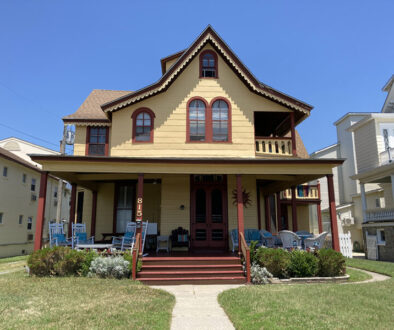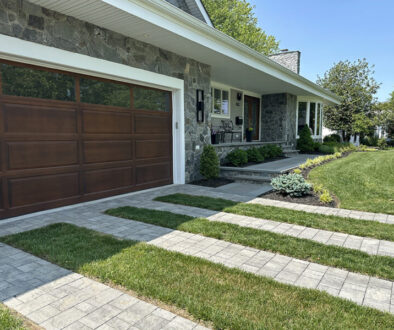The Franklin Street School: 720 Franklin Street
In an area once known as the center of a flourishing African American community, anchored by its landowners, and further developed by its business owners, a building stands as a poignant reminder of a significant time in our nation’s history. The Franklin Street School, built in 1927, was constructed as an elementary school for the town’s African American children at a time when segregation in public education—and in most accommodations—was the norm. What’s more, the structure wasn’t even entirely devoted to the black students. In fact, the gymnasium at the rear of the building was used by the nearby integrated high school—and, while attached, was inaccessible from the elementary school.

The Franklin Street School, designed by Edwards and Green of Philadelphia, is representative of the Colonial Revival style—a popular architectural style of the early 20th century, particularly for public school buildings, as the US approached its Sesquicentennial. It can be described as a resurgence of the architectural features prevalent during late 18th- and early 19th-century America, namely those from the Georgian and Federal styles. Colonial Revival buildings can be identified by orthogonal design (involving right angles), with consistent rhythmic qualities and symmetry.
Generally, Colonial Revival school buildings were designed to convey a sense of solidity and permanence, with a focus on simplicity and balance. More specifically, these schools typically featured façades with stacked openings, including central entrances and operable multi-pane windows. The buildings were designed to be functional and efficient, with a focus on providing good lighting and ventilation. This was especially important in an era before air conditioning. The exteriors of such schools were usually made of brick, stone, or a combination of both. Exterior wall construction often incorporated several decorative elements that were common in the original colonial architecture. These might include decorative moldings, pilasters, and pediments. Franklin Street School exhibits all these characteristics.
For those who aren’t aware, the building is presently undergoing major construction work to repurpose this former school and the connected gymnasium behind it into the newest branch of the Cape May County Library system. The current project has been designed and managed by local architect, Michael Calafati, AIA, who over various intervals has worked since 2001 to preserve this building. The project has been made possible by six public funding sources – the New Jersey State Library (Library Construction Bond Act Grant), the Cape May County Library Commission, the County of Cape May, the City of Cape May, the New Jersey Historic Trust (Preserve New Jersey Fund), and the National Park Service (African American Civil Rights Grant). Funding from three sources—NJ State Library, NJ Historic Trust, and the NPS—was awarded on a competitive basis.
As its name would convey, the school’s main entrance faces Franklin Street. It is centered on the building’s north elevation and features a cast stone door surrounded with the words “FRANKLIN STREET SCHOOL” engraved into the architrave. The entrance includes a recessed pair of historic wood doors each with six lites (or panes), a five-lite transom, and a straight brick stair flanked by brick and stone sidewalls. The school’s primary building material is modular brick arranged in a traditional running bond. The selection of brick as the building’s envelope has stood the test of time but has clearly experienced some wear over the years, and as such will undergo tedious raking and repointing of all mortar joints. In the process, the brick veneer will be re-anchored to the concrete block structural wall behind it. These measures will ensure that every square inch of the exterior walls is sound.


Like others of its era, the school features expansive window openings. Those on the front of the building form banks of five historic wood double hung sash windows, each with 12 lites, cast stone sills, and brick lintels in a soldier course pattern—existing at both the first and second floor levels. These windows provide ample natural light to the spacious classrooms of the building’s interior. Though they have been removed during construction, the original window units are being meticulously restored and will be reinstalled. Similarly, historic ten-over-ten wood sash windows at the upper floors of the rear two-story volume will also be restored, once again flooding the mirrored stairwells with sunlight. Those stairs can be accessed from the exterior of the building by paired, six-lite wood doors under a five-lite transom, and a cast stone panel engraved with either “BOYS” or “GIRLS.”
The library’s circulation desk will be situated at its new main entrance, on the south side of the building, facing the shared drive between it and the new firehouse. This side approach has historically been the entry point to the gymnasium. There, a visitor will arrive at a metal and glass door set within one of four large arched openings, the only one extending down to the floor level. The remaining three openings are closed with cast stone sills set roughly five feet above the ground. The windows that were originally set in these openings were removed some time ago, so custom replica units will be fabricated to replace them. Relocating the library’s main entrance is a strategic move to take advantage of the existing accessible entrance, accommodating those with disabilities. In doing so, the original front stair on the north side of the building is preserved.
Just past the circulation desk, the library will feature a dedicated children’s library section, in which we can surely expect regular sessions of story time with Miss Anita. Beyond that, the main stacks will occupy a portion of the former gym, both on the original maple hardwood ground floor as well as a new mezzanine level constructed in the double-height space. The young adults’ section, a computer lounge, and a study room will be located in a new addition constructed on the north-facing side of the original gymnasium, behind the Harriet Tubman Museum. When completed, the south wall of the new addition will actually be the restored north exterior wall of the gymnasium. As a result, the main stacks will gain borrowed light from the new interior windows set in the original exterior wall.
In the main school volume, original classrooms will take on new functions. The north classroom on the first floor will house the new headquarters for the Center for Community Arts, presently located just across the street, while the south classroom will become a reading space reserved for adults. On the second floor, the original folding wood partition, used to divide or consolidate the classrooms, will be restored to provide a flexible space for the community with all the amenities of a modern library. The basement level will contain a multi-purpose room with demonstration kitchen, along with restrooms and the requisite storage and utility spaces.
While the school was not built during a time when accessibility was of critical importance, long before the Americans with Disabilities Act became law, all can rest assured that every level of this building will be accessible. Inclusivity is an essential tenet in the design of the new library. Of particular significance is the fact that the two structures – the school and the gym – will be united for unmitigated circulation throughout all spaces. As previously noted, though physically attached, and sharing a structural masonry wall, these spaces were once completely separated. That changed last December when local residents—once students at the Franklin Street School—ceremoniously knocked down the wall that kept them from utilizing the adjacent gymnasium. This new opening will be framed to call attention to its importance. Though obviously isolated by the wall and sequestered to the school, you could not convince the alumni that they were at any sort of disadvantage. An icon of the community and former student at Franklin Street School, Emily Dempsey, recalls “We didn’t feel deprived at all. Our teachers never missed a day of school. They were all so dedicated.”




Many Colonial Revival school buildings of the time are still in use today and are valued for their historic and architectural significance. Overall, the style was intended to connect with America’s colonial past and evoke a sense of tradition and stability. Its popularity in school buildings reflected the belief that education was a key part of American society and that school buildings should convey a sense of importance and dignity. The irony is that a school constructed to segregate one group of children from another embodies the antithesis of importance and dignity. The discrimination rampant at the time was a product of a reprehensible institution of Early America, which ultimately contributed to the instability the country faced during the Civil Rights Movement, unfolding shortly after the integration of the Franklin Street School in 1949.
Today, the Franklin Street School – for years spared by the wrecking ball – is finally undergoing an extensive restoration and renovation, but also experiencing a reincarnation to become a new center of learning with a commitment to inclusivity. The original architecture will be retained and preserved as a vestige of the past, while the interior will be remodeled to express a new vision for the future. The hope is that a common practice of learning to accept all types of people, things and ideas fairly and equally might forever outlive our buildings.



